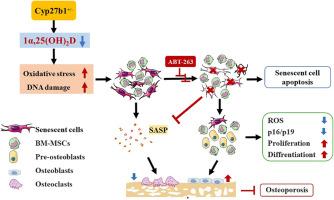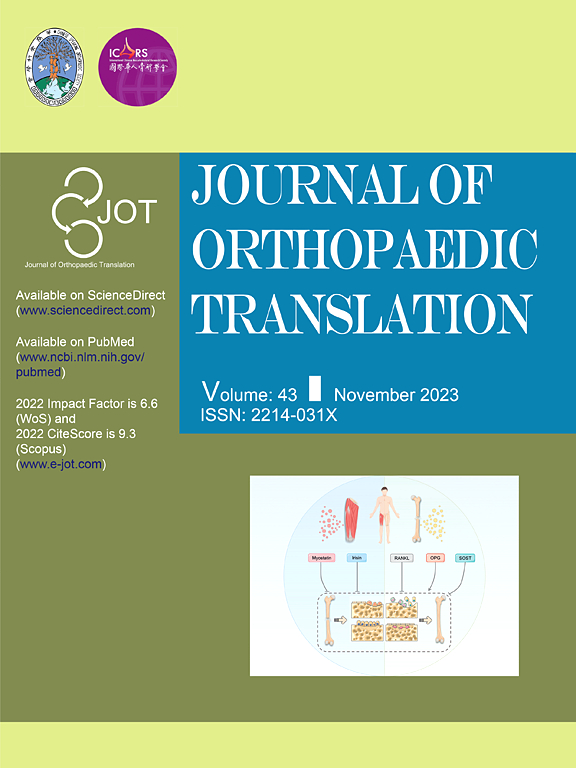衰老剂 ABT263 通过选择性清除衰老骨骼细胞,改善活性维生素 D 不足引起的骨质疏松症
IF 5.9
1区 医学
Q1 ORTHOPEDICS
引用次数: 0
摘要
背景/目的活性维生素D不足会加速骨质疏松症的发展,其中衰老骨细胞和衰老相关分泌表型(SASP)起着至关重要的作用。本研究旨在探讨衰老剂ABT263是否能通过选择性清除衰老细胞来纠正活性维生素D不足引起的骨质疏松症。方法在体外用ABT263处理来自年轻和老年小鼠的骨髓间充质干细胞(BM-MSCs),在体内给1,25(OH)2D不足(Cyp27b1+/-)的小鼠注射ABT263。结果ABT263通过下调Bcl2和上调Bax的表达诱导衰老的BM-间充质干细胞凋亡。ABT263还能诱导1,25(OH)2D不足小鼠的衰老BM-间充质干细胞凋亡。服用 ABT263 可增加骨密度、骨量、骨小梁数量、骨小梁厚度和胶原合成,从而纠正 1,25(OH)2D不足引起的骨质流失。它还能增强成骨细胞的骨形成,减少破骨细胞的骨吸收。ABT263 可促进 BM 间充质干细胞的增殖和成骨分化,从而纠正其受损的成骨作用。此外,ABT263 还能通过增加 SOD-2 和降低 γ-H2A.X 的表达,纠正 1,25(OH)2D 不足引起的氧化应激和 DNA 损伤。最后,ABT263 通过减少衰老和 SASP 相关基因和蛋白的表达,纠正了 1,25(OH)2D 不足引起的骨细胞衰老和 SASP。这些发现为老年溶解剂在治疗与活性维生素 D 不足有关的骨质疏松症方面的潜在治疗应用提供了新的见解。通过选择性地消除衰老骨细胞及其相关的 SASP,ABT263 的干预显示出了恢复骨平衡、防止进一步骨质流失和促进骨形成的能力。越来越多的研究支持将衰老疗法用于预防和治疗与年龄有关的骨骼疾病,这些研究结果为这一趋势做出了贡献。这项研究的转化潜力在于开发针对细胞衰老的新型治疗策略,以防治骨质疏松症,尤其是在维生素 D 不足是诱因的情况下。我们有必要开展进一步的临床研究,以验证 ABT263 和其他衰老溶解剂治疗人类骨质疏松症的有效性和安全性。本文章由计算机程序翻译,如有差异,请以英文原文为准。

The senolytic agent ABT263 ameliorates osteoporosis caused by active vitamin D insufficiency through selective clearance of senescent skeletal cells
Background/Objective
Active vitamin D insufficiency accelerates the development of osteoporosis, with senescent bone cells and the senescence-associated secretory phenotype (SASP) playing crucial roles. This study aimed to investigate whether the senolytic agent ABT263 could correct osteoporosis caused by active vitamin D insufficiency by selectively clearing senescent cells.
Methods
Bone marrow mesenchymal stem cells (BM-MSCs) from young and aged mice were treated with ABT263 in vitro, and 1,25(OH)2D-insufficient (Cyp27b1+/−) mice were administered ABT263 in vivo. Cellular, molecular, imaging, and histopathological analyses were performed to compare treated cells and mice with control groups.
Results
ABT263 induced apoptosis in senescent BM-MSCs by downregulating Bcl2 and upregulating Bax expression. It also induced apoptosis in senescent BM-MSCs from 1,25(OH)2D-insufficient mice. ABT263 administration corrected bone loss caused by 1,25(OH)2D insufficiency by increasing bone density, bone volume, trabecular number, trabecular thickness, and collagen synthesis. It also enhanced osteoblastic bone formation and reduced osteoclastic bone resorption in vivo. ABT263 treatment corrected the impaired osteogenic action of BM-MSCs by promoting their proliferation and osteogenic differentiation. Furthermore, it corrected oxidative stress and DNA damage caused by 1,25(OH)2D insufficiency by increasing SOD-2 and decreasing γ-H2A.X expression. Finally, ABT263 corrected bone cell senescence and SASP caused by 1,25(OH)2D insufficiency by reducing the expression of senescence and SASP-related genes and proteins.
Conclusion
ABT263 can correct osteoporosis caused by active vitamin D insufficiency by selectively clearing senescent skeletal cells, reducing oxidative stress, DNA damage, and SASP, and promoting bone formation while inhibiting bone resorption. These findings provide new insights into the potential therapeutic application of senolytic agents in the treatment of osteoporosis associated with active vitamin D insufficiency.
The translational potential of this article
This study highlights the therapeutic potential of ABT263, a senolytic compound, in treating osteoporosis caused by active vitamin D insufficiency. By selectively eliminating senescent bone cells and their associated SASP, ABT263 intervention demonstrates the ability to restore bone homeostasis, prevent further bone loss, and promote bone formation. These findings contribute to the growing body of research supporting the use of senolytic therapies for the prevention and treatment of age-related bone disorders. The translational potential of this study lies in the development of novel therapeutic strategies targeting cellular senescence to combat osteoporosis, particularly in cases where vitamin D insufficiency is a contributing factor. Further clinical studies are warranted to validate the efficacy and safety of ABT263 and other senolytic agents in the treatment of osteoporosis in humans.
求助全文
通过发布文献求助,成功后即可免费获取论文全文。
去求助
来源期刊

Journal of Orthopaedic Translation
Medicine-Orthopedics and Sports Medicine
CiteScore
11.80
自引率
13.60%
发文量
91
审稿时长
29 days
期刊介绍:
The Journal of Orthopaedic Translation (JOT) is the official peer-reviewed, open access journal of the Chinese Speaking Orthopaedic Society (CSOS) and the International Chinese Musculoskeletal Research Society (ICMRS). It is published quarterly, in January, April, July and October, by Elsevier.
 求助内容:
求助内容: 应助结果提醒方式:
应助结果提醒方式:


